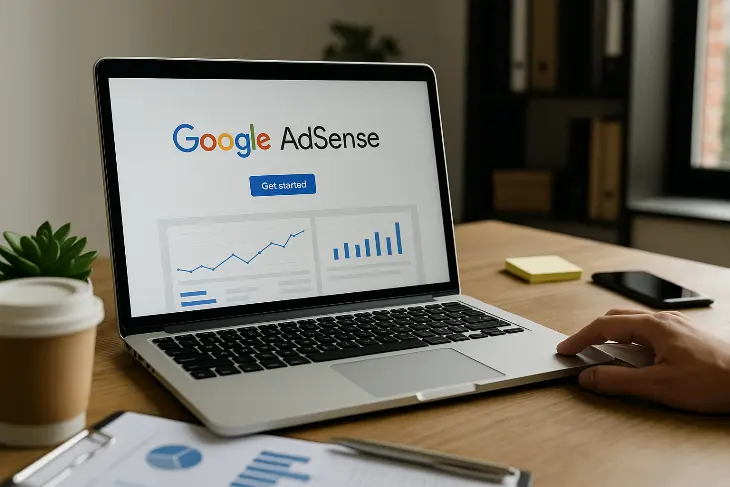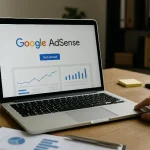Whether you’re a blogger, niche site owner, or digital publisher, Google AdSense offers one of the easiest and most accessible ways to monetize your website.
With no need to sell products or services, you can start earning passive income simply by displaying targeted ads.
The best part? You can get started in just a few minutes.
Also Read
This step-by-step guide will walk you through how to set up Google AdSense the right way – and how to optimize your earnings from the very start.
What is Google AdSense?
Google AdSense is an advertising program run by Google that lets publishers display text, image, video, or interactive ads on their websites. You earn money when visitors view or click these ads.
It’s powered by Google’s AdWords advertisers, which means the ads are highly relevant to your content and your visitors.
Why AdSense is Perfect for Beginners
- Free and easy to join
- No products, inventory, or customer service needed
- Ads are automatically matched to your content
- Great for passive income
- Backed by Google’s large network of advertisers
Whether your site gets 100 or 100,000 visitors a month, AdSense scales with your traffic.
Step-by-Step: How to Set Up Google AdSense
1. Apply for a Google AdSense Account
Visit https://www.google.com/adsense and click “Get Started.” You’ll need:
- A Google account (like Gmail)
- A live website with original content
- Your contact and payment information
Make sure your website has:
- At least 10–15 pages of quality content
- A Privacy Policy, About page, and Contact page
- A clean, user-friendly design
- No copyright-infringing, adult, or prohibited content
Once submitted, Google will review your site (usually within 1–3 days).
2. Get Approved and Access Your Dashboard
Once you’re approved, you’ll get access to your AdSense dashboard, where you can:
- Create ad units
- View performance reports
- Set payment preferences
- Manage your account info
This is your command center for all things AdSense.
3. Create and Customize Ad Units
Head to “Ads” > “By ad unit” in your dashboard to manually place ads, or select “Auto Ads” to let Google handle placements.
Manual ad setup gives more control. You can choose from:
- Display ads (text and image)
- In-feed ads (within blog feeds)
- In-article ads (within content)
- Link ads (text links based on keywords)
- Search ads (custom search engine with ads)
Customize:
- Ad size (responsive is best for mobile)
- Colors and fonts to match your site’s design
- Ad type (text, image, or both)
Once done, copy the JavaScript ad code provided.
4. Place the Ad Code on Your Website
Paste the code into your site’s HTML. Ideally, place it in:
- The sidebar
- Within blog posts
- Above or below content
- Header/footer (for site-wide display)
For WordPress users:
- Use Insert Headers and Footers plugin
- Or place it in widgets, theme editor, or ad management plugins
Tips: Test different placements to see what drives the most engagement without hurting user experience.
5. Wait for Ads to Appear
Once your code is live:
- Google crawlers scan your site
- Ads will start displaying relevant content
- Earnings will begin accumulating based on clicks (CPC) or impressions (CPM)
Understanding Your AdSense Dashboard
The AdSense dashboard gives you full visibility into your earnings and ad performance. Here’s what to pay attention to:
- Estimated earnings: Your projected income based on recent activity
- Page views: Total views of pages displaying ads
- Clicks: Number of times users clicked on ads
- CPC (Cost Per Click): How much you earn per ad click
- CTR (Click Through Rate): % of users clicking on ads
- RPM (Revenue per 1,000 views): An easy way to track earnings based on traffic volume
Use these insights to refine your content and ad placement strategy.
Tips to Maximize Your AdSense Earnings
1. Focus on High-Quality, Searchable Content
- Write long-form content (1,000+ words)
- Target high-CPC keywords using tools like Ubersuggest or Google Keyword Planner
- Answer real questions your audience is searching for
2. Experiment with Ad Placement
- Test different ad locations
- Blend ads naturally into content
- Avoid overloading pages (Google allows 3 display ads per page)
3. Choose the Right Niche
Some niches earn more per click. Examples:
- Finance (loans, credit cards, insurance)
- Tech (software, hosting, gadgets)
- Health and wellness
- Legal and real estate
4. Use Responsive Ads
Responsive ad units automatically adjust to different screen sizes, improving user experience – and ad earnings – on mobile devices.
5. Avoid Policy Violations
Google is strict. Make sure your site:
- Doesn’t contain adult, violent, or copyrighted content
- Doesn’t encourage users to click on ads
- Has clear navigation and quality content
Violations can result in account suspension or ban – don’t risk it.
How Long Does It Take to Earn Money?
- Most users start seeing impressions within 24–48 hours
- Click-based revenue starts accumulating as soon as users interact with ads
- Payout threshold is $100, paid monthly (via bank transfer or wire)
Consistency is key. As your site gains more traffic, your revenue will naturally grow.
Absolutely – if you do it right.
Google AdSense is one of the simplest and most scalable monetization models for content creators. It works 24/7, requires no selling, and is backed by Google’s trusted ad network.
If you create high-quality content, grow your traffic, and follow best practices, AdSense can become a reliable source of passive income – and even a full-time income stream.















